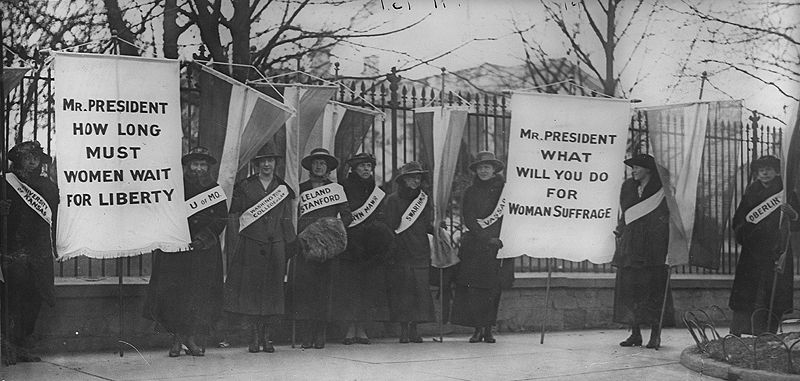Women have come far in the last 100 years, but we still have a ways to go until true gender equality
Photo used with permission under a Creative Commons License
Women suffragists protesting in front of the White House in 1917.
April 22, 2020
On Aug. 18, 1920, the day the Nineteenth Amendment was ratified in the United States, the women of America took their first major step towards gender equality. And on the 100th anniversary of women’s suffrage, we can look back and celebrate the advances women have made over the last century. Susan B. Anthony fought for the right to vote, Margaret Chase Smith set the precedent that women could be elected to congress, and Madeleine Albright proved women could be powerful figures in international affairs. But although the centennial will be a day to admire how far women have come, there is still much to accomplish before true equality is attained in America.
“I believe that women have made a lot of progress, especially in job opportunities. Women used to just stay at home while the men would go out and work. But now, more women are working for themselves,” freshman Leticia Freitas said. According to an article on The Balance Careers website, “In 1950, about one in three women participated in the labor force. By 1988, nearly three of every five women of working age were in the labor force.” The increase of women working not only further strengthens the labor force but shows great progress in proving that women are capable of working for themselves.
“Women have proven to men that they can accomplish great things just like them many times,” junior Golda Ering said. Hillary Clinton, being a prime example of this, who was the first woman in U.S. history to represent a major party in a presidential election. Powerful women like her had dreams, and this year we celebrate their perseverance in making those dreams come true, paving the way for others that will follow in their footsteps.
“We have progressed a lot, but still there is work to be done that can not be ignored. We are still not equal to men.” freshman Emma Hubbard said. According to the American Association of University Women, “in comparison to white men, white women make 77 cents to their dollar, black women make 61 cents, and Latina women make just 53 percent.”
Though women have made a major transformation in society since 1920, shedding the expectation that females should only be the housewife and instead pursuing successful professional careers. But they are still valued less than an equivalent male counterpart, suffering from both intentional and unintentional gender bias.
Venturing beyond America, women in some parts of the world find themselves in even more dire situations. In countries such as Afghanistan, if girls even try to seek schooling, they are often hunted and killed by terrorist groups such as the Taliban. According to an article from Iowa State Daily, “There are about 80 countries where progress on girls’ education has stalled in not meeting the Millennium Development Goals.” This means that millions of girls from these countries have little to no access to primary education, often being passed over for boys in the same areas.
However, women have never stopped fighting and will continue to fight for complete global equality. Michelle Bachelet, the former president of Chile, created a far-reaching education program that raised the government’s investment in public education for all. Likewise, actress Christina Hendricks performed an Equal Pay public service announcement in 2014, where she brought her former “Mad Men” character’s 60’s style to a modern office setting in order to make a point about gender inequality.
Come this August, we should celebrate and praise all the women of America and their progress in the fight for equality between both sexes. But we also must use this special anniversary as a reminder that despite the great success, there is still more fighting to be done. Though with the constant progress women are making every day, the point of ultimate equality is finally within sight. Now is time for women to seize it, running into the light at the end of the tunnel.


